The variable air volume (VAV) system market is experiencing strong growth driven by increasing demand for energy-efficient HVAC solutions, rising construction of commercial buildings, and stringent regulatory standards for indoor air quality and energy management. The market landscape is being shaped by the integration of smart control technologies, advanced sensors, and automated systems that enhance air distribution efficiency and operational flexibility.
Current market trends indicate growing adoption across developed and emerging economies as industries and real estate developers prioritize sustainability and cost optimization. Manufacturers are focusing on system design innovation, modular configurations, and compatibility with building management systems to improve installation convenience and performance efficiency.
The future outlook remains positive as government initiatives promoting green building standards and retrofit programs for aging infrastructure are expected to accelerate adoption The overall growth rationale is centered on increasing awareness of life-cycle energy savings, reduced carbon footprint, and enhanced occupant comfort, establishing VAV systems as a cornerstone technology within modern HVAC frameworks.
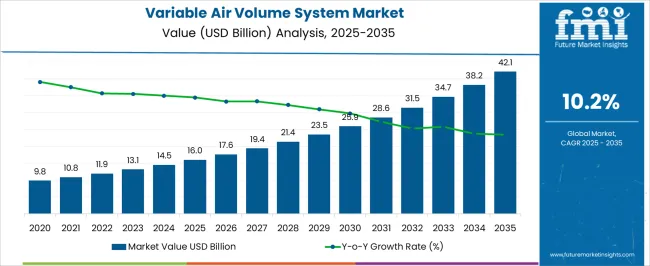
| Metric | Value |
|---|---|
| Variable Air Volume System Market Estimated Value in (2025 E) | USD 16.0 billion |
| Variable Air Volume System Market Forecast Value in (2035 F) | USD 42.1 billion |
| Forecast CAGR (2025 to 2035) | 10.2% |
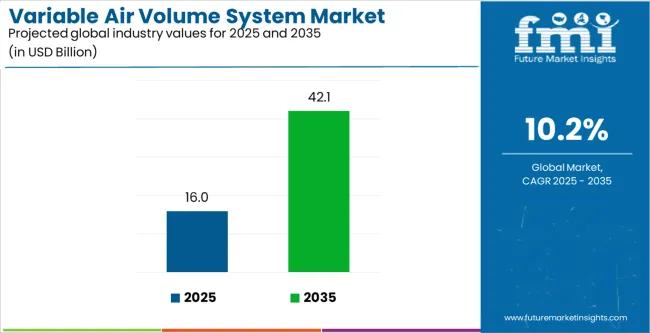
The market is segmented by Product Type and Application and region. By Product Type, the market is divided into Multiple-Zone VAV and Single-Zone VAV. In terms of Application, the market is classified into Commercial, Residential, and Industrial. Regionally, the market is classified into North America, Latin America, Western Europe, Eastern Europe, Balkan & Baltic Countries, Russia & Belarus, Central Asia, East Asia, South Asia & Pacific, and the Middle East & Africa.
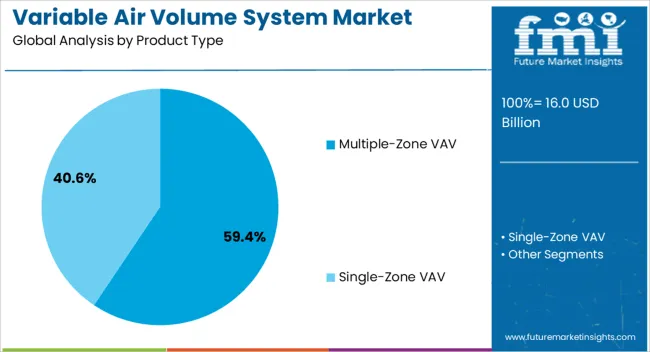
The multiple-zone VAV segment, holding 59.40% of the product type category, has emerged as the dominant segment due to its superior ability to control temperature and airflow across multiple zones within large facilities. This design provides improved energy efficiency and comfort compared to single-zone configurations.
Market leadership is being reinforced by its extensive adoption in complex structures such as office buildings, hospitals, and educational institutions, where varying occupancy patterns require dynamic airflow adjustments. Advancements in digital control systems and integration with IoT-enabled devices have further enhanced performance monitoring and predictive maintenance capabilities.
Manufacturers are emphasizing modular designs and compact components to simplify installation and maintenance As global building standards increasingly prioritize smart and sustainable systems, the multiple-zone VAV segment is expected to sustain its market share and continue to be a preferred choice for energy-efficient and high-performance HVAC installations.
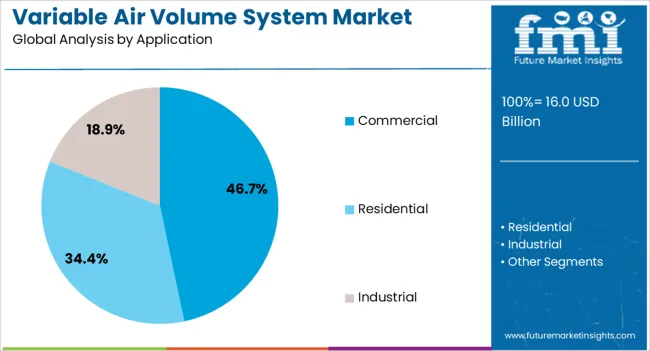
The commercial segment, representing 46.70% of the application category, has maintained its leadership due to the extensive deployment of VAV systems in office complexes, retail centers, hotels, and institutional buildings. The segment’s dominance is supported by rising demand for optimized climate control, occupant comfort, and energy savings across high-traffic environments.
Growth has been further accelerated by modernization projects and retrofitting initiatives aimed at enhancing building energy performance. The adoption of automation and centralized monitoring within commercial infrastructure has contributed to better system management and reduced operational costs.
Regulatory mandates promoting energy-efficient air distribution systems have strengthened the market position of VAV systems in commercial spaces Continued urbanization, expansion of the service sector, and the proliferation of smart buildings are expected to reinforce the segment’s share, ensuring steady growth and sustained preference for VAV installations in commercial applications.
Emergence of Compact Designs to Spur Demand
The commercial building and construction sector is experiencing significant demand due to the increasing popularity of air volume modulation systems. Apart from that, these systems are set to be used in various industries such as retail, hospitality, and warehouses, leading to rising demand.
Variable air volume systems are highly preferred in a wide range of sectors as compared to traditional HVAC systems. These systems provide multiple benefits, like low power consumption, reduced fan noise, and enhanced precision, thereby spurring growth.
Single-zone variable air volume systems are one of the dominant categories of this sector. Growth is attributed to several features, such as dehumidification, quiet operation, and reliability. Launch of products with compact designs that are easy to install and maintain is a key variable air volume system market trend.
High Installation Cost and Lack of Expertise to Hamper Demand
The global sector is anticipated to face several challenges in the forecast period. The cost of VAV system installation and maintenance compared to traditional constant air volume (CAV) systems is high. Change in raw material prices is expected to slow down growth. The maintenance cost of these products is estimated to hamper the industry.
Availability of alternative technologies limits variable air volume system market growth. Lack of expertise in developing nations hinders access to these systems. Stringent government regulation also creates a significant restraint on industry development.
Emphasis on Energy Reduction Methods to Create Opportunities
The sector is primarily driven by the rapid diversification of end-use verticals in developing economies. The utilization of elastomers and polymers, as well as a high emphasis on energy reduction, is set to push the industry.
High expenditure on construction projects has a significant impact on the adoption of variable air volume systems. The impact of government regulations on building energy codes and VAV system adoption is significant, shaping the future of the variable air volume system market.
The variable air volume system market experienced considerable growth from 2020 to 2025, with a CAGR of 13.1%. By 2025, the sector reached a total value of USD 14,480 million.
In the historical period from 2020 to 2025, new players entered the market, and demand for innovative products and services surged. The sector faced economic fluctuations and increased competition. Despite these obstacles, the market exhibited resilience and adaptability, paving the way for future developments.
Looking ahead, the industry is poised for expansion and evolution. A few developments include the integration of advanced technologies, such as artificial intelligence and blockchain, into various components. Increasing consumer preference for sustainable and eco-friendly products is anticipated to compel key players to adopt environmentally conscious practices.
Surging demand for single-zone and multiple-zone variable air volume increases the preference for centralized cooling systems. The future of VAV systems in a net-zero energy-building environment is promising. This is due to high energy efficiency, less noise, better dehumidification, and compact design, making these easy to install and manage.
Globalization and devitalization will likely continue to shape the industrial landscape and foster new opportunities for growth and diversification. The launch of innovative products, including next-generation smart devices, advanced healthcare solutions, and revolutionary transportation technologies, is anticipated to push demand.
These innovations will likely redefine consumer experiences and industry standards, setting the stage for a dynamic and competitive landscape of the VAV system market.
The section below outlines trends and growth drivers of leading countries in Asia Pacific, North America, Europe, and other regions. These countries are projected to offer favorable opportunities for growth and development.
| Countries | CAGR 2025 to 2035 |
|---|---|
| Canada | 6.2% |
| Spain | 7.7% |
| France | 7.1% |
| China | 11.4% |
| India | 15.2% |
The variable air volume system market in France is rising due to stringent energy efficiency regulations and government incentives for green buildings. The country is estimated to witness a CAGR of 7.1% during the forecast period. Sales of air volume modulation systems are rising due to consumer awareness and demand for energy-efficient HVAC systems.
Technological advancements in smart building solutions further drive the adoption of these systems. Increasing awareness of indoor air quality among building owners further boosts the country.
Modernization of aging infrastructure requires efficient HVAC solutions. Apart from that, high energy costs encourage the use of energy-saving air modulation systems.
The government’s focus on reducing carbon emissions supports the air volume modulation sector. Booming growing construction sector, particularly in urban areas, fuels demand for advanced HVAC technologies. The overall construction industry growth is driving demand for new HVAC systems in France.
Spain is anticipated to register a 7.7% CAGR during the projected period from 2025 to 2035. Booming tourism sector is leading to increased hotel and commercial building construction activities. Energy efficiency regulations are becoming strict, driving the need for advanced HVAC solutions.
Government regulations on building energy efficiency standards are promoting VAV systems in Spain. Growing focus on reducing operational costs in commercial spaces encourages the adoption of modulating air volume systems.
Growing awareness of indoor air quality among businesses and homeowners supports growth of the sector. Expanding real estate sector is anticipated to boost demand for air volume modulation systems.
India is set to rise due to increasing number of infrastructure projects. The country is expected to witness a significant CAGR of 15.2% by 2035. Demand for efficient HVAC solutions is rising with increasing construction of commercial buildings. Government initiatives promoting energy-efficient buildings play a crucial role in this expansion.
Emphasis on reducing energy consumption in the commercial sector is set to support the adoption of air volume modulation systems. Positive factors impacting VAV system market investment include technological advancements and smart building solutions.
The booming IT and retail sectors are contributing to high demand in India. Furthermore, the focus on improving indoor air quality at workplaces and public buildings is a key growth driver for VAV systems. Environmental regulations are also encouraging the use of advanced HVAC technologies in India.
The following section includes the segmentation analysis of the air volume modulation sector. The in-depth analysis would help companies invest in the dominant categories. The single-zone segment by product type is estimated to lead, followed by the industrial segment in terms of application.
| Segment | Single Zone VAV (Product Type) |
|---|---|
| Value Share (2025) | 45.4% |
The single-zone VAV segment leads with a share of 45.4% in 2025 in the variable air volume system sector due to high cost-effectiveness and easy installation. These are set to be ideal for small to medium-sized buildings.
The systems provide precise temperature control for separate zones, enhancing energy efficiency and reducing operational costs. Government incentives or tax breaks for installing energy-efficient HVAC systems like VAV are projected to augment sales. Increased demand for energy-efficient single-zone solutions in commercial spaces would further spur sales.
Growing awareness of the benefits of good indoor air quality supports growth. Single-zone air volume modulation systems are ideal for retrofit projects in old buildings.
These are also scalable and adaptable for various building types. Technological advancements in HVAC systems continue to drive the adoption of single-zone variable airflow systems, ensuring the leading position.
| Segment | Industrial (Application) |
|---|---|
| Value Share (2025) | 54.4% |
The industrial segment is set to be the dominant application category, with a 54.4% share in the variable airflow system sector. This is due to high demand for efficiency and precision. Industries prioritize energy savings and improved airflow management, which are crucial for maintaining optimal operational conditions.
VAV systems provide precise control over air distribution, enabling better temperature regulation and energy efficiency. This results in low operational costs and enhanced productivity across industries. Innovations like advanced sensors and smart controls enhance the performance and reliability of variable airflow systems, further boosting sales.
New technologies allow for real-time monitoring and adjustments, ensuring optimal environmental conditions. Integration of modulating air volume systems with building management systems (BMS) also contributes to high popularity. This provides comprehensive control over various building operations, leading to improved efficiency and reduced energy consumption.
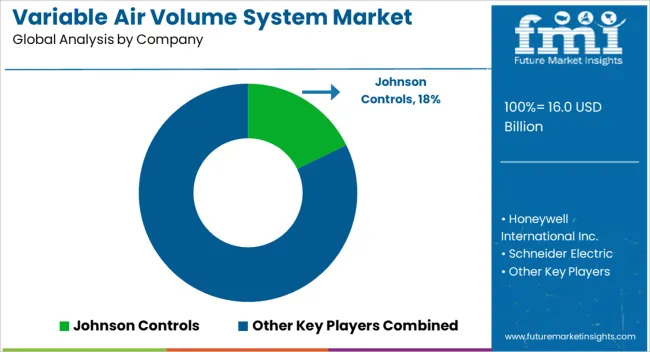
The variable air volume system market is highly competitive, with top VAV system manufacturers and new entrants striving to innovate. Companies are launching new variable airflow systems for HVAC solutions. The introduction of new features such as energy-efficient temperature control and air quality management for use in commercial buildings is set to create opportunities.
Companies invest in research and development to launch advanced, energy-efficient variable airflow systems with IoT integration. Custom solutions, strategic partnerships, and entry to high-growth regions would also help firms compete.
Meeting green building standards and offering robust after-sales service enhance customer satisfaction, which is a key strategy for success in the VAV system market.
Leading Players in the Industry
Leading product types in the variable air volume system sector are single-zone VAV and multiple-zone VAV.
Dominant applications of variable air volume systems are residential, commercial, and industrial.
An analysis has been carried out covering key countries in various regions like North America, Latin America, Europe, East Asia, South Asia, Oceania, and the Middle East and Africa.
The global variable air volume system market is estimated to be valued at USD 16.0 billion in 2025.
The market size for the variable air volume system market is projected to reach USD 42.1 billion by 2035.
The variable air volume system market is expected to grow at a 10.2% CAGR between 2025 and 2035.
The key product types in variable air volume system market are multiple-zone vav and single-zone vav.
In terms of application, commercial segment to command 46.7% share in the variable air volume system market in 2025.






Full Research Suite comprises of:
Market outlook & trends analysis
Interviews & case studies
Strategic recommendations
Vendor profiles & capabilities analysis
5-year forecasts
8 regions and 60+ country-level data splits
Market segment data splits
12 months of continuous data updates
DELIVERED AS:
PDF EXCEL ONLINE
Variable Shunt Reactor Market Size and Share Forecast Outlook 2025 to 2035
Variable Valve Timing Market Size and Share Forecast Outlook 2025 to 2035
Variable Displacement Compressor Market Size and Share Forecast Outlook 2025 to 2035
Variable Reluctance Sensor Market Size and Share Forecast Outlook 2025 to 2035
Variable Speed Generators Market Analysis & Forecast by Technology, End Use and Region through 2035
Variable Data Printing Market Analysis – Growth & Forecast through 2034
Variable Frequency Drive Market Growth – Trends & Forecast 2024-2034
Marine Variable Frequency Drives Market Size and Share Forecast Outlook 2025 to 2035
Air Core Variable Shunt Reactor Market Size and Share Forecast Outlook 2025 to 2035
Automotive Variable Displacement Pumps Market Size and Share Forecast Outlook 2025 to 2035
Automotive Variable Oil Pump Market Growth – Trends & Forecast 2024-2034
Automotive Variable Discharge Oil Pump Market
Large Scale Variable Frequency Drives Market Size and Share Forecast Outlook 2025 to 2035
Continuously Variable Transmission (CVT) Market Size and Share Forecast Outlook 2025 to 2035
Single Phase Variable Shunt Reactor Market Size and Share Forecast Outlook 2025 to 2035
North America Variable Frequency Drives Market Growth – Trends & Forecast 2024-2034
Aircraft Electric Motor Market Size and Share Forecast Outlook 2025 to 2035
Airborne Radar Market Size and Share Forecast Outlook 2025 to 2035
Airport Ground Transportation Market Forecast and Outlook 2025 to 2035
Airless Sprayer Accessories Market Size and Share Forecast Outlook 2025 to 2035

Thank you!
You will receive an email from our Business Development Manager. Please be sure to check your SPAM/JUNK folder too.
Chat With
MaRIA